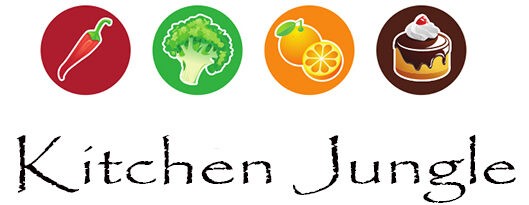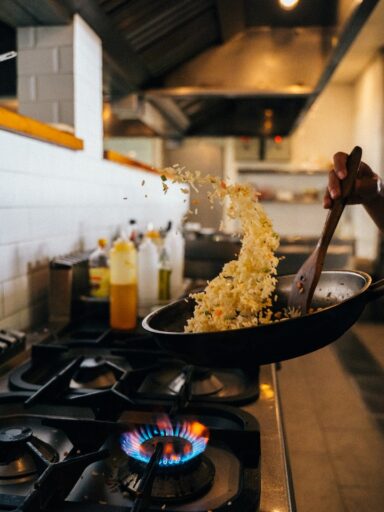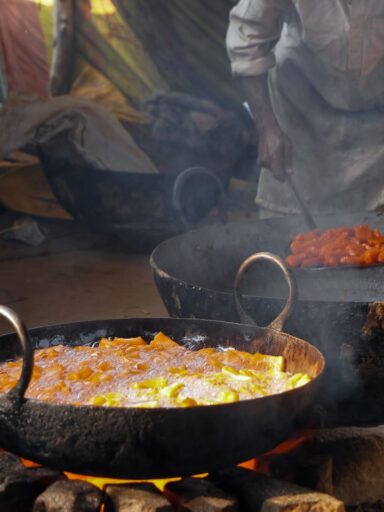Definition of Ceramic Pans
Ceramic pans are non-stick cookware made primarily from clay and mineral-based materials. They are specifically designed to cook food at high temperatures evenly without sticking, making them an excellent alternative to traditional non-stick pans. Unlike traditional non-stick pans that use synthetic materials like Teflon, ceramic pans are environmentally friendly and safe to use.
Brief History of Ceramic Pans
Ceramic has a rich history that dates back thousands of years. In ancient times, clay pots and pans were used extensively for cooking, baking, and storing food. These early ceramic vessels were made by hand using mud and clay, which were then baked in open fires or kilns.
Fast forward to the modern era; the first ceramic frying pan was invented in France around 1819 by Francois Coignet but was not popularized until much later during the 1950s. Since then, there have been major advancements in technology that have resulted in the development of more efficient and durable ceramic pans.
Advantages of Using Ceramic Pans
Using a ceramic pan offers several advantages over traditional non-stick cookware options. Firstly, they are chemical-free since they don’t contain any harmful substances like perfluorooctanoic acid (PFOA) or polytetrafluoroethylene (PTFE). Secondly, ceramic pans distribute heat equally across their surface area due to their unique composition of natural materials like minerals.
Another advantage of using a ceramic pan is its ability to retain heat after being removed from the stove or oven because it has better insulation properties than other materials such as stainless steel or cast iron. This ability allows you to keep your cooked food warm even after removing it from the heat.
Choosing a ceramic pan over traditional cookware is an excellent option for anyone who is health-conscious, environmentally friendly, or concerned with evenly cooked food. In the following sections, we will explore different types of ceramic pans, the benefits of using them for cooking, how to choose the right ceramic pan, and tips for using and maintaining it.
Types of Ceramic Pans
Pure Ceramic Pans
Pure ceramic pans are made entirely of ceramic materials, such as clay, that have been kiln-fired to create a non-porous surface. They are highly durable and can withstand high temperatures without cracking or warping.
Pure ceramic pans are an excellent choice for those who want a completely non-toxic cooking surface as they do not contain any harmful chemicals or metals that can leach into food. One of the main advantages of pure ceramic pans is their ability to distribute heat evenly throughout the cooking surface.
This ensures that food cooks uniformly and reduces the risk of hot spots which can cause burning or undercooking. Additionally, pure ceramic pans tend to be naturally non-stick which makes cleaning up a breeze.
However, pure ceramic pans can be somewhat heavy and may take longer to heat up compared to other materials. They also require a bit more care and attention when it comes to cleaning and maintenance as they cannot be cleaned with abrasive cleaners or utensils.
Ceramic Coated Pans
Ceramic-coated pans feature a metal base with a layer of ceramic on top. The metal base is typically made from aluminum or stainless steel which provides good heat conduction and durability while the ceramic coating adds a non-stick layer for easy cooking and cleaning.
One advantage of using ceramic-coated pans is their affordability compared to pure ceramic pans which can be quite expensive. They also tend to be lighter in weight than pure ceramic pans making them easier to handle in the kitchen.
Ceramic-coated pans are also available in various colors which can add some style and personality to your kitchen decor. However, it’s important to note that over time the coating may wear off or become scratched if not properly cared for.
While both types of ceramic pans have their pros and cons, ultimately it comes down to personal preference and cooking needs. Pure ceramic pans offer a completely non-toxic and durable surface while ceramic-coated pans provide a more affordable option with added versatility.
Benefits of Using Ceramic Pans for Cooking
Non-toxic and Safe to Use
One of the biggest advantages of using ceramic pans for cooking is that they are non-toxic and safe to use. Unlike traditional non-stick pans which are coated with toxic chemicals, ceramic pans are made from natural materials like clay and sand. This means that they do not release any harmful chemicals or toxins into your food, even at high temperatures.
This is especially important if you are health-conscious and want to avoid exposing yourself or your family to potentially dangerous substances. With ceramic pans, you can have peace of mind knowing that what you’re cooking is safe and healthy.
Non-stick Surface for Easy Cooking and Cleaning
Another benefit of using ceramic pans is their non-stick surface which makes cooking and cleaning a breeze. The surface is so smooth that food doesn’t stick to it, making it easy to cook delicate foods like fish or eggs without worrying about them sticking.
What’s more, cleaning up after cooking with a ceramic pan is easy since there’s no need for scrubbing or soaking. The non-stick surface allows food particles to slide off easily with just a little bit of soap and water.
Even Heat Distribution
Ceramic pans also distribute heat evenly throughout the entire pan which helps prevent hot spots from forming. Hot spots can cause uneven cooking leading to burned food in some areas while others remain undercooked.
With even heat distribution, you can cook your food evenly throughout the pan leading to better-tasting meals overall. This feature also helps save energy since less heat is needed due to efficient heat distribution.
Versatile for Different Types of Cooking
Ceramic pans are versatile when it comes to different types of cooking methods including frying, sautéing, searing, braising, and baking. They can be used on various cooktops including gas, electric, and induction since they are compatible with different heat sources. This versatility makes ceramic pans a great investment in your kitchen since they can be used for multiple cooking techniques.
Additionally, they come in different sizes and shapes to suit different cooking needs. For example, there are small ceramic pans for making omelets or pancakes and larger ones for preparing stir-fries or stews.
Ceramic pans offer numerous benefits when it comes to healthy cooking techniques. They’re non-toxic and safe to use, have a non-stick surface that makes cleaning a breeze, and distribute heat evenly throughout the pan which leads to better-tasting meals overall.
And lastly, their versatility makes them a great investment in your kitchen arsenal. Using ceramic pans can help you cook healthier meals while making cooking easier and more enjoyable overall.
How to Choose the Right Ceramic Pan
Size and Shape
Choosing the right size and shape of the ceramic pan is essential to ensure that you can cook your favorite dishes efficiently. If you’re cooking for one or two people, a small 6-inch or 8-inch pan will work best. However, if you have a large family or frequently host dinner parties, you may want to consider larger pans like 10-inch or 12-inch models.
When it comes to shape, consider what types of food you cook most often. A square-shaped pan is perfect for making frittatas or scrambled eggs while a round-shaped one works well for sautéing vegetables and searing meats.
Quality of the Material
The quality of the material used in the ceramic pan is another crucial factor to consider when choosing the right one. High-quality ceramic pans are durable and long-lasting, resist scratches and stains, and maintain their non-stick surface for an extended period.
Look for pans with thick bottoms as they distribute heat evenly throughout cooking. Additionally, choose those made from safe materials like lead-free glazes.
Compatibility with Cooktops
Consider your cooktop before purchasing a ceramic pan as different types of stovetops require different kinds of cooking surfaces. Ceramic pans work well with electric stovetops but not with induction ones since they aren’t magnetic.
It’s also worth noting that certain types of ceramic pans may not be suitable for use on gas stoves as they tend to slide around due to their glazed surface contacting with the grates directly. Choosing the right ceramic pan doesn’t have to be complicated if you keep these factors in mind before making your purchase decision.
Think about what foods you’ll be cooking most often and how many people you’ll be serving – this will help determine what size and shape of the pan to buy. Look for high-quality ceramic pans with thick bottoms and non-toxic coatings, and check your cooktop’s compatibility before you make a final selection.
Tips for Using and Maintaining Ceramic Pans
Seasoning the Pan Before First Use
Before using your ceramic pan for the first time, it’s important to season it properly. This helps to seal the surface of the pan and make it more non-stick.
To season your pan, heat it on medium-high heat with a small amount of oil in it, such as vegetable or canola oil. Allow the oil to coat the entire bottom surface of the pan until it begins to smoke slightly.
Remove from heat and let cool completely before wiping away any excess oil with a paper towel. Your pan is now ready for use!
Avoiding Abrasive Cleaners and Utensils
Ceramic pans have a delicate non-stick surface that can be easily scratched or damaged by abrasive cleaners or utensils. Avoid using steel wool or metal utensils on your ceramic pan, as they can scratch the surface and cause damage over time.
Instead, use soft sponges or cloths with gentle dish soap to clean your pan after each use. If you’re dealing with tough stains or burnt-on food, try soaking your ceramic pan in hot water mixed with a mild dish soap before scrubbing gently with a non-abrasive sponge.
Storing the Pan Properly
Proper storage of your ceramic pans is important for maintaining their longevity and performance over time. Avoid stacking multiple pans on top of each other, as this can scratch or damage their surfaces. Instead, store them individually in a dry location where they won’t be knocked around or exposed to temperature extremes.
To protect their non-stick surfaces during storage, place paper towels or cloth napkins between each pan. If you’re short on cabinet space, consider hanging them from hooks above your cooktop instead!
Conclusion
After careful examination of ceramic pans, it is evident that they are a great addition to any kitchen. The benefits of using them for cooking are numerous, including their non-toxic and non-stick properties, even heat distribution, and versatility for different types of cooking.
Choosing the right ceramic pan requires considering the size and shape, quality of the material, and compatibility with cooktops. Additionally, proper use and maintenance involve seasoning the pan before first use, avoiding abrasive cleaners and utensils, and storing the pan properly.
Summary of Key Points
Ceramic pans come in two types: pure ceramic pans and ceramic-coated pans. Pure ceramic pans are made from solid clay that is fired at high temperatures while coated ceramic pans have a metallic base with a ceramic layer on top.
Benefits include non-toxic properties that make them safe to use in cooking as well as having a non-stick surface that allows for easy cleaning after cooking. Choosing the right pan involves considering factors like size/shape as well as compatibility with cooktops.
To maintain your ceramic pan’s longevity it’s recommended to season it before its first use which will help imbue your food with flavor throughout subsequent uses. Avoid heavy-duty scrubbing or harsh detergents when cleaning so you don’t scratch or damage its surface.
Future Outlook on Ceramic Pans
Ceramic pans have been around for centuries but have seen recent surges in popularity due to concerns over Teflon coatings in traditional non-stick cookware. Given their safety benefits compared to other materials like Teflon along with their versatility across different countertop ranges means they are bound to remain popular into the future.
In addition to growing popularity among home cooks, we might expect manufacturers to continue innovating new designs utilizing this material which could aim for improved durability or further improvements in heat retention. Regardless of future developments, the humble ceramic pot will surely continue to be a reliable and economical addition to any kitchen that’s worth considering for all your cooking needs.




